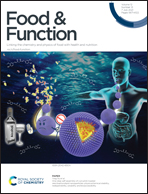The neuroprotective effects of isoquercitrin purified from apple pomace by high-speed countercurrent chromatography in the MPTP acute mouse model of Parkinson's disease
Abstract
Parkinson's disease is the second most common neurodegenerative disease. Researchers have shown that oxidative stress and apoptosis play an important role in the Parkinson's disease process. Isoquercitrin (quercetin-3-O-β-D-glucopyranoside) is a natural flavonol compound and one of the main active ingredients of agricultural waste apple pomace. Increasing evidence indicates that this compound possesses anti-oxidation, anti-aging, and anti-inflammation properties. In this study, isoquercitrin was purified from apple pomace by high-speed countercurrent chromatography and its neuroprotective effect on Parkinson's disease was investigated in MPTP-induced acute mouse models. It was found that isoquercitrin ameliorated the animal behaviors against MPTP-induced neurotoxicity, mitigated the loss of dopamine neurons induced by MPTP, increased tyrosine hydroxylase and dopamine transporter expression, reduced the pro-apoptotic signaling molecule bax expression and inhibited MPTP-triggered oxidative stress. Our results demonstrated that isoquercitrin has protective effects on the MPTP subacute model mouse, which might be partially mediated through the actions of anti-oxidation and anti-apoptosis. Isoquercitrin might be a new promising protective drug for the improvement of Parkinson's disease.



 Please wait while we load your content...
Please wait while we load your content...